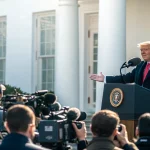Russia’s growing ties with China could be nudging Beijing to rethink tariffs, according to Osaic chief market strategist Phil Blancato, raising fresh questions about the next phase of U.S.-China trade policy. The comment arrives as Washington maintains and expands duties on Chinese goods and as Beijing weighs its own responses.
Blancato warned that a tariff fight produces few winners. He argued that both the United States and China suffer when barriers go up, a view borne out by years of data from the last round of tariff exchanges.
“Russia might be moving China’s position on tariffs.”
—Phil Blancato, Osaic chief market strategist
A shifting triangle: Moscow, Beijing, Washington
China and Russia have deepened economic ties since 2022, with energy trade and financial cooperation increasing as Moscow seeks partners under Western sanctions. This alignment gives Beijing more options as it faces pressure from U.S. trade actions, including new duties on sectors such as electric vehicles and solar components.
Closer links could encourage China to recalibrate tariff policy, either to shield strategic industries or to signal resolve in response to U.S. steps. That recalibration could also involve seeking alternative markets and supply lines that reduce reliance on U.S. demand.
Blancato’s point suggests that Russia’s role is not just diplomatic. The shift could shape how Beijing sets import duties, export controls, and industrial support, especially in technologies central to long-term growth.
What a renewed tariff fight would mean
Tariffs are taxes on imports. The Trump administration imposed duties on roughly $370 billion in Chinese goods under Section 301. Subsequent research found that most costs were passed to U.S. importers and consumers through higher prices. The Biden administration kept those tariffs in place and, in 2024, increased rates in targeted sectors, including electric vehicles, batteries, and solar cells.
Economists widely agree that higher tariffs can raise input costs for manufacturers, complicate supply chains, and weigh on growth. China’s exporters face slower sales and margin pressure. U.S. firms importing parts or finished goods may contend with tighter budgets and pricing decisions that risk demand.
“The United States and China lose from a trade war.”
—Phil Blancato
Consumer impacts tend to show up in electronics, apparel, and household goods where import shares are high. For producers, tariffs can prompt relocation of sourcing to third countries, which often takes time and money.
Lessons from the last tariff cycle
Research from U.S. academic institutions and central banks estimated tens of billions of dollars in annual costs to U.S. consumers and firms during the prior tariff rounds. Price increases were evident in categories with limited alternative supply. At the same time, some U.S. producers gained short-term protection from foreign competition, though gains often faded as supply chains adjusted.
For China, export growth slowed in affected sectors while shipments to other markets rose. Trade diverted to Southeast Asia, Mexico, and parts of Europe as companies re-routed assembly and sourcing to avoid duties, sometimes with Chinese-made inputs embedded in final goods.
The net effect was a more complicated and expensive trading system without a clear lift to overall growth on either side. That experience informs investor caution as policy signals shift again.
Industry and market implications
Autos, clean energy hardware, semiconductors, and consumer electronics are most exposed. Tougher tariffs in these areas would likely raise project costs and slow adoption timelines, particularly for energy transition gear that depends on Chinese supply.
Equity markets may react to tariff headlines with higher volatility, especially in cyclical sectors and firms reliant on cross-border inputs. Currency moves could add to uncertainty if capital seeks safety during policy shifts. Bond markets may price in slower growth if tariffs widen and persist.
What to watch next
- Signals from Beijing on tariff schedules, export controls, and support for key industries.
- U.S. reviews under Section 301 and any new sector-specific duties.
- Trade diversion through third countries and new customs enforcement steps.
- Corporate guidance on pricing, inventories, and sourcing plans.
Blancato’s warning offers a practical takeaway: policy shifts rarely occur in isolation. Russia’s closer alignment with China adds another variable for U.S. businesses and investors to weigh as they plan for the next year.
For now, evidence from recent years points to higher prices, supply rerouting, and slower trade when tariffs escalate. If Moscow’s influence nudges Beijing toward tougher measures, the drag could broaden. Companies with exposure to targeted goods may benefit from stress-testing supply chains, hedging input costs, and mapping alternative sourcing.
The bigger question is whether Washington and Beijing can find limited deals that lower uncertainty while keeping strategic guardrails. The next set of tariff decisions—and any response shaped by China’s ties with Russia—will signal whether the two largest economies risk another costly standoff or chart a steadier path.







